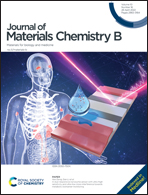Artificial cell membrane camouflaged immunomagnetic nanoparticles for enhanced circulating tumor cell isolation†
Abstract
Precise and specific circulating tumor cell (CTC) isolation is heavily interfered with by blood cells and proteins. Although satisfactory results have been achieved by some cell membrane-derived platforms, the following limitations have seriously limited the commercialization potential: complex membrane composition, difficult batch difference control, inconvenient source cell expansion, etc. To overcome these limitations, artificial cell membrane camouflage made from commercialized lipids and proteins was proposed in this work. Specifically, a biotinylated phospholipid which can serve as a lipid component and provide active sites (biotin) for antibody modification, and human serum albumin (HSA), which can effectively reduce certain blood protein adsorption, were applied simultaneously to endow our immunomagnetic platform with a new biological identity. Besides, making full use of the robust lipid and protein absorption ability of graphene nanosheets (GNs), the biomimetic cell membrane can be easily integrated into the magnetic core through simple lipid and protein solution incubation. Surprisingly, the resulting artificial cell membrane camouflaged immunomagnetic nanoparticles (AIMNPs) achieved high specificity (average capture efficiency 87.0%), good sensitivity (7 model CTCs per 0.5 mL) and an enhanced anti-nonspecific absorption ability (15–105 white blood cells per 1.5 mL) in both mimic and clinical blood samples.



 Please wait while we load your content...
Please wait while we load your content...